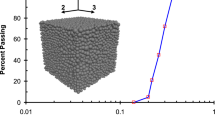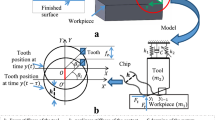Abstract
Die filling is an important part of the powder handling process chain that greatly influences the characteristic structure and properties of the final part. Predictive modelling and simulation of the die-filling process can greatly contribute to the optimization of the part and the whole production procedure, e.g. by predicting the resulting powder compaction structure as a function of filling process parameters. The rheology of powders can be very difficult to model especially if heterogeneous agglomeration or time-dependent consolidation effects occur. We present a new discrete element contact force model that enables modelling complex powder flow characteristics including direct time-dependent consolidation effects and load history-dependent cohesion to describe the filling process of complex, difficult to handle powders. The model is demonstrated for simple flow and an industrial powder flow.










Similar content being viewed by others
References
Brewin PR, Coube O, Doremus P, Tweed JH (eds) (2008) Modelling of powder die compaction. Springer, London
German RM (1996) Sintering theory and practice. Wiley-VCH, New-York
Bierwisch C, Kraft T, Riedel H, Moseler M (2009) Three-dimensional discrete element models for the granular statics and dynamics of powders in cavity filling. J Mech Phys Solids 57:10–31. doi:10.1016/j.jmps.2008.10.006
Bierwisch C, Kraft T, Riedel H, Moseler M (2009) Die filling optimization using three-dimensional discrete element modeling. Powder Technol 196:169–179. doi:10.1016/j.powtec.2009.07.018
Guo Y, Wu CY, Kafui KD, Thornton C (2010) Numerical analysis of density-induced segregation during die filling. Powder Technol 197:111–119. doi:10.1016/j.powtec.2009.09.003
Tomas J (2001) Assessment of mechanical properties of cohesive particulate solids. Part 2: powder flow criteria. Part Sci Technol 19:111–129. doi:10.1080/02726350152772065
Tomas J (2003) The mechanics of dry, cohesive powders. Powder Handl Process 15:296–314
Thakur SC, Morrissey JP, Sun J et al (2014) Micromechanical analysis of cohesive granular materials using the discrete element method with an adhesive elasto-plastic contact model. Granul Matter 16:383–400. doi:10.1007/s10035-014-0506-4
Coube O, Cocks ACF, Wu C-Y (2005) Experimental and numerical study of die filling, powder transfer and die compaction. Powder Metall 48:68–76. doi:10.1179/003258905X37585
Kraft T, Riedel H (2002) Numerical simulation of die compaction and sintering. Powder Metall 45:227–231. doi:10.1179/003258902225006989
Coube O, Riedel H (2000) Numerical simulation of metal powder die compaction with special consideration of cracking. Powder Metall 43:123–131. doi:10.1179/003258900665871
Guo Z, Chen X, Liu H et al (2014) Effect of storage time on the flowability of biomass-coal granular system. Fuel Process Technol 125:59–66. doi:10.1016/j.fuproc.2014.03.030
Tomas J (2004) Fundamentals of cohesive powder consolidation and flow. Granul Matter 6:75–86. doi:10.1007/s10035-004-0167-9
Oñate E, Celigueta MA, Latorre S, Casas G, Jerzy Rojek RR (2014) Lagrangian analysis of multiscale particulate flows with the particle finite element method. Comput Particle Mech 1:85–102. doi:10.1007/s40571-014-0012-9
Rojek J, Labra C, Su O, Oñate E (2012) Comparative study of different discrete element models and evaluation of equivalent micromechanical parameters. Int J Solids Struct 49:1497–1517. doi:10.1016/j.ijsolstr.2012.02.032
Cundall PA, Strack ODL (1979) A discrete numerical model for granular assemblies. Géotechnique 29:47–65. doi:10.1680/geot.1979.29.1.47
Cante JC, Riera MD, Oliver J et al (2010) Flow regime analyses during the filling stage in powder metallurgy processes: experimental study and numerical modelling. Granul Matter 13:79–92. doi:10.1007/s10035-010-0225-4
Oñate E, Franci A, Carbonell JM (2014) A particle finite element method for analysis of industrial forming processes. Comput Mech 54:85–107. doi:10.1007/s00466-014-1016-2
Wu CY, Cocks aCF (2006) Numerical and experimental investigations of the flow of powder into a confined space. Mech Mater 38:304–324. doi:10.1016/j.mechmat.2005.08.001
Tomas J (2007) Adhesion of ultrafine particles–a micromechanical approach. Chem Eng Sci 62:1997–2010. doi:10.1016/j.ces.2006.12.055
Tykhoniuk R, Tomas J, Luding S et al (2007) Ultrafine cohesive powders: from interparticle contacts to continuum behaviour. Chem Eng Sci 62:2843–2864. doi:10.1016/j.ces.2007.02.027
Breinlinger T, Hashibon A, Kraft T (2015) Simulation of the influence of surface tension on granule morphology during spray drying using a simple capillary force model. Powder Technol 283:1–8. doi:10.1016/j.powtec.2015.05.009
Breinlinger T, Hashibon A, Kraft T (2015) Simulation of the spray drying of single granules: the correlation between microscopic forces and granule morphology. J Am Ceram Soc 9:1778–1786. doi:10.1111/jace.13557
Wu CY, Cocks ACF, Gillia OT, Thompson Da (2003) Experimental and numerical investigations of powder transfer. Powder Technol 138:216–228. doi:10.1016/j.powtec.2003.09.011
Derjaguin B, Muller V, Toporov Y (1975) Effect of contact deformations on the adhesion of particles. J Colloid Interface Sci 53:314–326. doi:10.1016/0021-9797(75)90018-1
Luding S (2006) Cohesive, frictional powders : contact models for tension. Granul Matter 10:235. doi:10.1007/s10035-008-0099-x
Thornton C, Ning Z (1998) A theoretical model for the stick/bounce behaviour of adhesive, elastic–plastic spheres. Powder Technol 99:154–162. doi:10.1016/S0032-5910(98)00099-0
Guo Y, Curtis JS (2015) Discrete element method simulations for complex granular flows. Annu Rev Fluid Mech 47:21–46. doi:10.1146/annurev-fluid-010814-014644
Hertz H (1881) On the contact of elastic solids. J Reine Angew Math 92:156–171
Johnson KL, Kendall K, Roberts AD, Johnsont KL (1971) Surface energy and the contact of elastic solids. Source Proc R Soc London Ser A, Math Phys Sci 324:301–313
Tomas J (2001) Assessment of mechanical properties of cohesive particulate solids—part 1: particle contact constitutive model. Part Sci Technol 19:95
Johnson KL (1985) Contact mechanics. J Am Chem Soc 37:1–17. doi:10.1115/1.3261297
Israelachvili JN (2011) Intermolecular and surface forces, 3rd edn. Academic Press, San Diego
Weuster A, Brendel L, Wolf DE (2013) Simulation of sheared, caking powder. In: AIP Conference Proceedings of 7th International Conference in Micromechanics Granul Media (Powders Grains) Locat Sydney, Aust Date JUL 08–12, 2013 515:515–518. doi:10.1063/1.4811981
Landau LD, Pitaevskii LP, Kosevich AM, Lifshitz EM (1986) Theory of elasticity, 3rd edn. Elsevier, Amsterdam
Glöß B, Fries M, Michaelis A, Analyse des Matrizenfüllprozesses beim uniaxialen Trockenpressen mittels einer integrierten Versuchsmethode. Prep
Acknowledgments
This work has been funded by the Federal Ministry of Economics and Technology (BMWi) via the German Federation of Industrial Research Associations “Otto von Guericke“ e.V. (AiF) (IGF-Nr.: 430 ZBG) and by the IPROCOM Marie Curie initial training network, funded through the People Programme (Marie Curie Actions) of the European Union’s Seventh Framework Programme FP7/2007–2013/ under REA Grant Agreement No. 316555. This research has also been partially supported by the EU FP7 Project SimPhoNy (Grant Number 604005).
Author information
Authors and Affiliations
Corresponding author
Rights and permissions
About this article
Cite this article
Hashibon, A., Schubert, R., Breinlinger, T. et al. A DEM contact model for history-dependent powder flows. Comp. Part. Mech. 3, 437–448 (2016). https://doi.org/10.1007/s40571-015-0099-7
Received:
Accepted:
Published:
Issue Date:
DOI: https://doi.org/10.1007/s40571-015-0099-7




